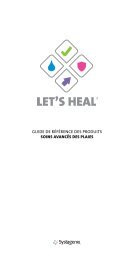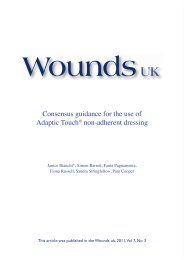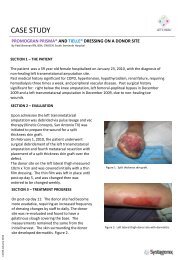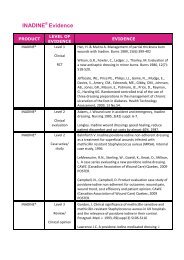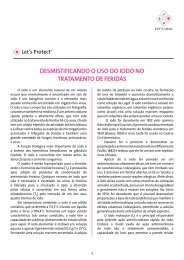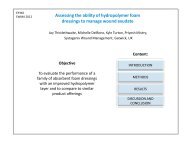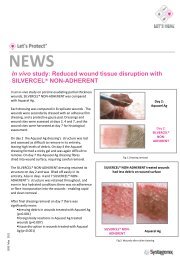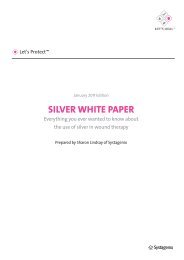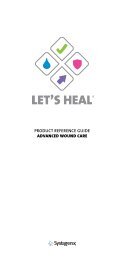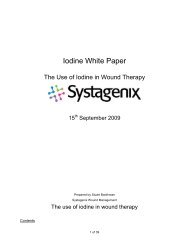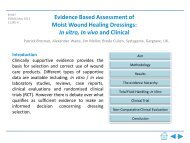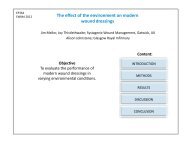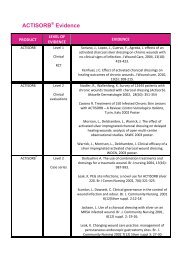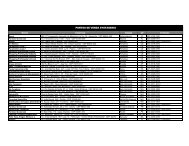USING ADAPTIC TOUCH® Non-Adhering Silicone ... - Systagenix
USING ADAPTIC TOUCH® Non-Adhering Silicone ... - Systagenix
USING ADAPTIC TOUCH® Non-Adhering Silicone ... - Systagenix
You also want an ePaper? Increase the reach of your titles
YUMPU automatically turns print PDFs into web optimized ePapers that Google loves.
<strong>ADAPTIC</strong> TOUCH® <strong>Non</strong>-<strong>Adhering</strong> <strong>Silicone</strong> Dressing<br />
to slowly reduce the extent of the contact layer. The patient was anxious that when<br />
<strong>ADAPTIC</strong> TOUCH® was no longer used, she would experience severe pain again.<br />
As a result, application of <strong>ADAPTIC</strong> TOUCH® was limited to the sides of the<br />
wound bed.<br />
Dressing change 4: (16 July) Ten days after the <strong>ADAPTIC</strong> TOUCH® was<br />
introduced as a wound contact layer, signs of healing continued to be seen.<br />
Granulation was estimated as 25–50% of the wound bed but the wound was<br />
not measured. Exudate levels were low. The wound contact layer had not<br />
adhered to the wound bed or the foam interface layer and it was easily removed.<br />
There were no signs of infection and a WOUNDCHEK Protease Status test<br />
indicated protease activity was not elevated. The patient rated pain as a 1 on the<br />
10-point scale. The regimen was continued.<br />
Dressing change 4<br />
Dressing change 5: (19 July) Exudate levels remained low and there were<br />
continued signs of healing. The wound continued to granulate (0–25%<br />
granulation tissue). The wound had reduced in size, as a result of its decreased<br />
depth (Figure 5). There were no signs of infection.<br />
The dressing was easy to remove and the patient reported being pain-free<br />
during dressing removal. As the patient was not experiencing pain she was more<br />
relaxed at dressing changes, anxiety levels were reduced and the nurse observed<br />
an increase in trust during their interactions. The patient was discharged and the<br />
plan was to continue the current treatment regimen with regular weekly reviews.<br />
However, she was lost to follow-up when she moved out of the area to be with<br />
her family.<br />
Outcome<br />
Both nurse and patient remained very satisfied with the dressing throughout the<br />
treatment period. The nurse found <strong>ADAPTIC</strong> TOUCH® very easy to use, since<br />
it could be cut to shape before removing the backing paper. <strong>ADAPTIC</strong> TOUCH®<br />
was easy to handle and place on the wound, and there were no problems with<br />
the passage of exudate into the canister. On presentation, the patient had been in<br />
considerable pain but agreed to further NPWT treatment with a reduced negative<br />
pressure and a change in the wound contact layer. The nurse believed that the<br />
alternative to using <strong>ADAPTIC</strong> TOUCH® and NPWT would have resulted in twice<br />
daily dressing changes, which would have negatively impacted the patient's<br />
wellbeing and increased the risk of the wound becoming infected. Using <strong>ADAPTIC</strong><br />
TOUCH® with NPWT improved the patient's quality of life (fewer dressing<br />
changes) and enabled early discharge.<br />
By: Janet McGowan, Lead Research Nurse, Bradford Wound Healing Unit|Bradford<br />
Institute for Health Research Clinical Research Facility, Bradford, UK<br />
Dressing change 5<br />
Figures 4-5: The patient reported decreased pain as<br />
the wound showed signs of healing.<br />
Assessment 1 2 3 4 5<br />
Patient pain<br />
scores before<br />
and during<br />
dressing<br />
changes<br />
(VAS 1-10)<br />
Protease<br />
activity<br />
2, 3 2, 2 1, 1 1, 1 1, 0<br />
Low n/a n/a Low n/a<br />
Wound size ¬ ¬ ¬ n/a <br />
<strong>ADAPTIC</strong> TOUCH® NON-ADHERING SILICONE DRESSING CASE STUDIES | 5


